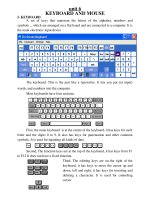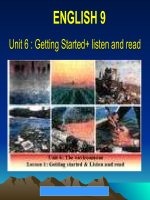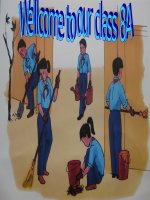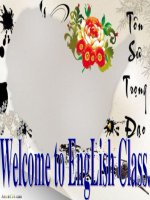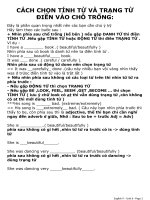unit 6 keyboard and mouse
Bạn đang xem bản rút gọn của tài liệu. Xem và tải ngay bản đầy đủ của tài liệu tại đây (422.3 KB, 10 trang )
unit 6
keyboard and mouse
I- keyboard
A set of keys that represent the letters of the alphabet, numbers and symbols ...
which are arranged on a flat board and are connected to a computer. It is the main
electronic input device
The keyboard. This is the part like a typewriter. It lets you put (or input)
words, and numbers into the computer
Most keyboards have four sections.
First, the main keyboard is at the centre of the keyboard, it has keys for each
letter and the digits 0 to 9. It also has keys for punctuation and other common
symbols. It is used for inputting all kinds of date.
Second, The function keys are at the top of the keyboard, it has keys from F1
to F12 It does not have a fixed function.
Third, The editting keys are on the right of the
keyboard, it has keys to move the cursor up and
down, left and right, it has keys for inserting and
deleting a chacracter. It is used for controling
cursor
Fourth, numeric keypad is far right, it has keys
for the digits 0 – 9, it also has keys for mathematical
operations. It is used for inputing numerical date
II- mouse
A mouse is a hardware device which
allows the user to control
a cursor to manipulate
data without complicated
commands.
The computer mouse is a hand
operated device that lets you control more
easily the location of the pointer on your
screen. You can make selections and
choices with the mouse button.
The mouse contains a rubber coated
ball that rests on the surface of your
working area or a mousemat. When the
mouse is moved over that surface, the ball
rolls.
The ball
’
s movements up and down,
and left and right, turn the two axles inside
the mouse. As they turn, detectors rigister
the changing position. A small intergrated
circuit inside the mouse sends signals to the
operating system, which instructs it to move
the pointer on your screen.
Aspects/'ổspekt/(n) hng
editting keys : phim soan thao
numeric keypad: vung phim so
Cursor /'k:s/ con nháy
digits /'didit/ con s
turn s quay; vũng quay, thay i
axle 'ổksl/trc xe
detector/di'tekt/b tỏch súng
register 'redist/ van, ca
intergate
interrupter cỏi ngt (in)
lp, coat: lp, lt (sn, vụi...)
instr Instruct (v) ch dn, ch th cho
Alternate /:l't:nit/ xen k, xen nhau
Inter La label /'leibl/ nhón, nhón hiu
confuse/kn'fju:z/ lm ln xn, lm
lung
tung, xỏo trn
serial ports: cổng nối tiếp
monitor: thiết bị kiểm soát
parallel port: cổng song song
visible thy c, cú th trụng thy
c
Delete /di'li:t/ (v) gch i, xoỏ i, b i
assignment /'sainmnt/ s giao
vic, s phõn cụng
execute /'eksikju:t/ thc hin, thi hnh,
tha hnh, chp hnh
Exercise.
1. Dựa vào bài để hoàn thành các thông tin trên bảng
Section Location Mainkeys Mainfunction
Mainkeyboard
top Not fixed
Cursor keys
Insert, delete a character
Input numerical
date
2. Dựa vào nội dung bài đọc để hoàn thành các câu sau.
1. Move the mouse to the left and the cursor moves to the............
2. The mouse contains a a rubber coated ...............
3. There are .........axles inside the mouse and two interrupter wheels
4. When you move the mouse. The ball...........
5. There are ......... sections on the keyboard.
6. The mouse moves over a mouse...........
3. Trả lời các câu hỏi sau.
1. How many sections are there in the keyboard?
2. What is the third section?What is its main function?
3. Which section is at the top of the keyboard?
4. Does the key F2 have a fixed function?
5. What is the keys for the digits 0 9 used?
6. The mouse is an input device, isn
t it?
4. Nối các tên viết tắt với các tên viết đầy đủ trên bàn phím.
1. Esc a. Alternate
2. Alt b. Page up
3. Ctrl c. Delete
4. Pgdn d. Insert
5. Pgup e. Escape
6. Ins f. Page down
7. Del g. Control
5. DÞch c¸c ®Þnh nghÜa sau ra tiÕng viÖt.
Escape: A key on the keyboard which is uesd to cancel
an operation or to exit a program. When users press
with another key to perform the special keyboard
function.
Alternate: A key on the keyboard that is pressed at the same time as another
key to access a range of characters and symbols.
Control: A key on the keyboard that is pressed at the
same time as another key to access functions
Page down: A key on the keyboard that user presses to view/see information
below the information, that is currently visible on the screen or in the window
Page up: A key on the keyboard that a user presses to view information above
the information, that is currently visible on the screen or in the window
Insert: A key on the keyboard that is used add a word etc to a text.
Delete: A key on the keyboard that is used to
remove words, etc from the text or files from a hard disk.
to remove a letter word or line etc from a piece of text...
Home: A key on the keyboard that is used to move the cursor to the beginning
of the line or the top of the screen, but the assignment of this key is up to the
programmer
End: A key on the keyboard that is used to move the cursor to the end of a
document or page
Num lock : A key on the keyboard that a user presses to change the mode of
the numeric keypad so that it produces a number for each key pressed.
Caps lock: A key on the keyboard that a user
presses to change the keyboard from lowercase to
uppercase or from uppercase to lowercase
Tab: A key on the keyboard that is used to
enter a fixed number of blank characters in a
document
Shift: A key on the keyboard that a user
presses to enter uppercase letters or punctuation
marks.
Enter: A key on the keyboard that a user
presses to tell the operating system to execute a
command or to mark the end of a paragraph in a
word processing program.
6. Dich ra tiếng việt.
1. External devices connect to ports at the back of the computer.
2. Deffirents types of the port are used for each device. Most computers have 1
keyboard port, 1 video port, 2 serial ports, 1 parallel port, Some also have a mouse
port. If there is no mouse port, a serial mouse must be used...
3. The mouse port and the keyboard look exactly the same but they have labels to
avoid confustion.
4. The serial ports often have the labels COM
1
and COM
2
. The monitor connects to
the video port. The printer uses the larger parallel port.
5. The most important electronic part of a computer is the motherboard. The largest
chip in the centre is the processor.
6. The memory chips is the brain of the computer.
7. Nối mỗi chữ cái của bức tranh với các định nghĩa


